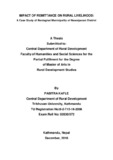Please use this identifier to cite or link to this item:
https://elibrary.tucl.edu.np/handle/123456789/2324| Title: | Impact of Remittance on Rural Livelihood |
| Other Titles: | A Case Study of Bardaghat Municipality of Nawalparasi District |
| Authors: | Kafle, Pabitra |
| Keywords: | Remittance;Socio-economic condition;Rural life |
| Issue Date: | 2016 |
| Publisher: | Central Department of Rural Development Tribhuvan University, Kathmandu |
| Abstract: | Nepal has been one of the greatest shareholders of global remittance but the issue is how such flows have been used in the livelihood of before and after receiving remittance at the households. The objective of this study is to identify how remittances impact various socio-economic dimensions of before and after receiving remittance. This study conducts an impact of surveying both before and after receiving remittance households in Bardaghat municipality, of the largest migrant-sending municipality in Nawalparasi District, and analyzes the impact gain resulting from remittance flows and use pattern in the study area. The research was conducted under ‘descriptive research design’ to fulfill the objectives of the study area. This study found that the main cause of foreign employment was unemployment. The foreign employment population in Qatar is higher than other countries. Most of the workers of study area were found working in the security guard which constitutes of the total employee population. The study also found out that households receiving money monthly is at the highest percentage. Foreign employment and agriculture is the main source of their income. Income transfer deepens upon availability of means of transfer. It is found that the highest channel for money transfer is money transfer agency. Money received from foreign employment is found being used in different purposes, different households have their own kinds of necessities and the use of money is also accordingly. The highest use is found to be upon the regular households expenditure, whereas, their uses are upon education, health, construction, loan payment and saving. Education expenditure is further studies to find out which aspect has the highest use of remittance. The study hence finds out that the highest rate of income is spend upon snacks. Remittance constitutes an integral part of household livelihood strategies. It permits households to income their consumption of local goods and services. Through the study it is found that the structure of the houses have been change after the employment. The number of cemented houses have been more, as a positive impact of the remittance. Similarly, the income generate after foreign employment, the number of employees who have high income is shown more than before employment. Also, lacking upon the change in assets structure, the study found out that in remittance receiving households, all goods and services are increased in economic condition has also raised awareness in Childs education. There is good food supply in the surveyed households after remittance, because of the regular income and increased purchasing capacity. The family economic condition is improved. The surveyed households have access to the good and healthy food and they can afford health expenditure. That is why their health condition has been improved after remittance. |
| URI: | http://elibrary.tucl.edu.np/handle/123456789/2324 |
| Appears in Collections: | Rural Development |
Items in DSpace are protected by copyright, with all rights reserved, unless otherwise indicated.

